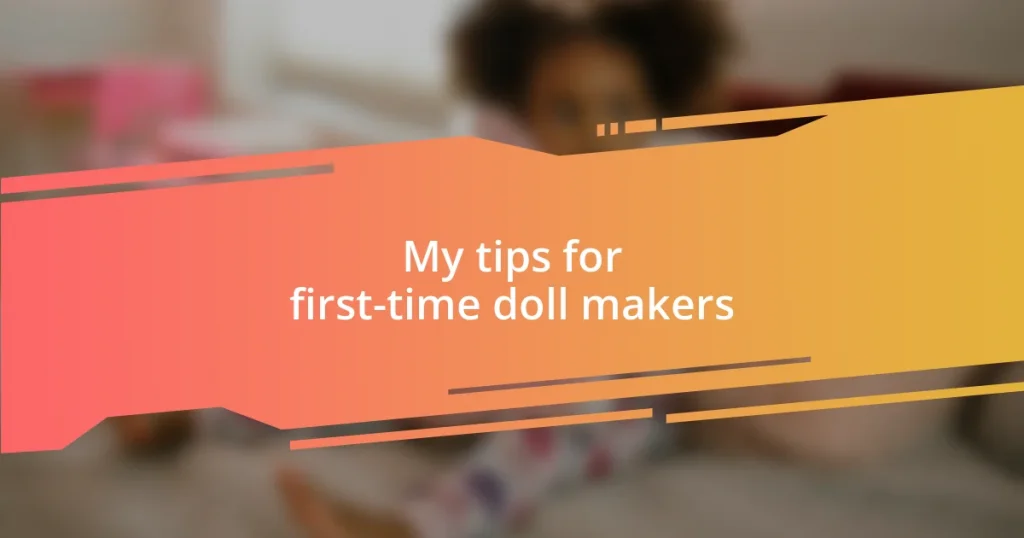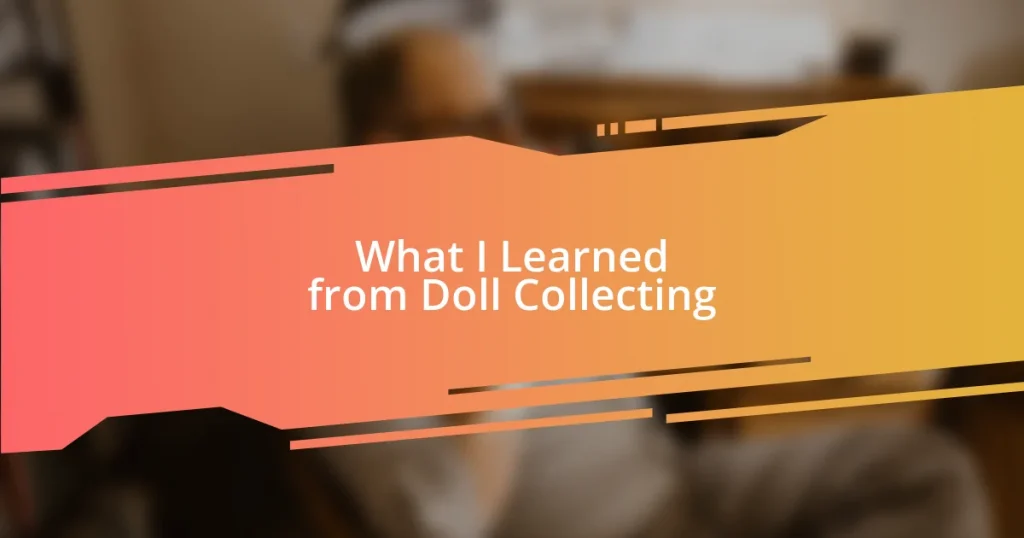Key takeaways:
- Start with a clear vision and plan for your doll, utilizing sketches to guide the design process and avoid frustration.
- Select appropriate materials by considering texture, weight, and drape, as well as experimenting with different options to find the best fit.
- Invest in essential tools and techniques, and focus on adding personal touches that reflect your creativity and enhance the doll’s character.
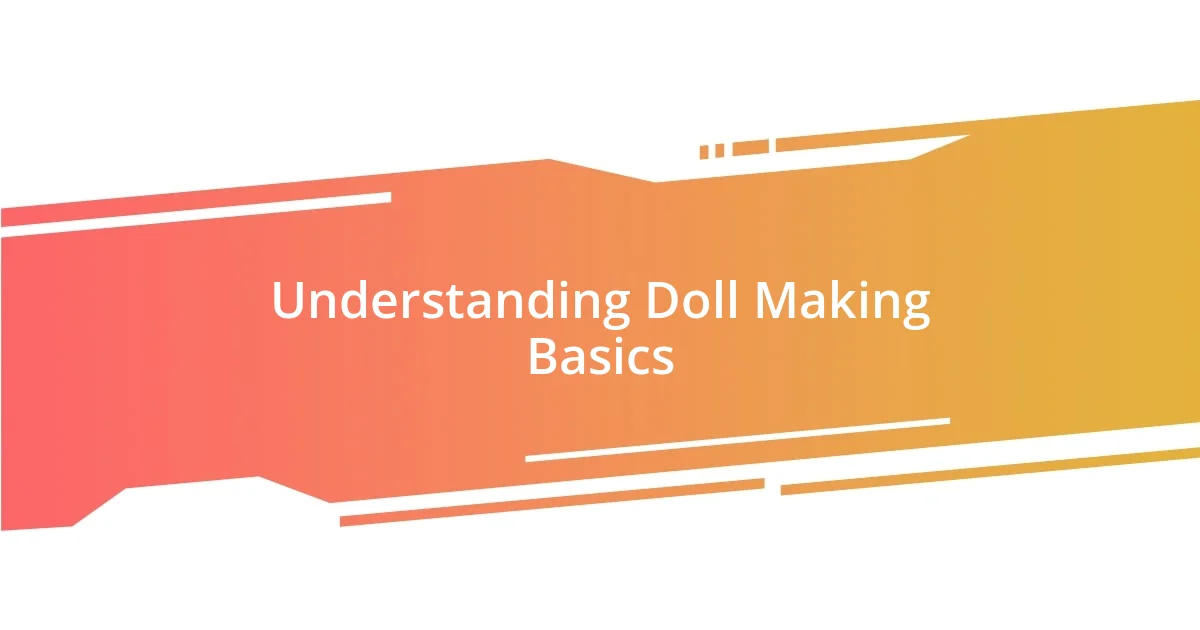
Understanding Doll Making Basics
Doll making is truly an art form that combines creativity and craftsmanship. I still remember my first attempt; I was overwhelmed by the array of materials available, from fabric to hair fibers. How does one even begin to choose? It’s essential to start with basic supplies like fabric, stuffing, and thread. A solid foundation in these materials opens the door to endless possibilities in design.
As I navigated my early projects, I learned that having a clear vision is crucial. I once tried to replicate a character from a favorite childhood book, but the absence of a plan left me frustrated and uninspired halfway through. Have you ever felt that way? I found that sketching out my ideas not only helps to clarify my thoughts but also gives direction to the entire crafting process.
One of the first lessons in doll making is understanding proportions. Initially, I struggled with getting the arms and legs to match the head size, resulting in some rather unusual-looking creations. Have you faced similar challenges? It’s normal! By practicing and adjusting proportions through trial and error, I began to appreciate the nuances of doll making. Embracing these small setbacks really helped me grow as a creator and reminded me that every artist’s journey is filled with learning moments.

Choosing the Right Materials
Choosing the right materials can make all the difference in the quality and feel of your doll. I remember my first project; I chose a fabric that looked beautiful but felt too stiff for what I envisioned. This experience taught me to consider not only the visuals but also the texture and drape of the material. It’s vital to choose fabric that aligns with the personality of your doll—whether that’s soft fleece for a cuddly companion or flowing silk for something more elegant.
When it comes to stuffing, choose wisely! I once used synthetic stuffing that felt lumpy and underwhelming. Switching to natural cotton stuffing not only improved the feel of the doll but made it easier to shape. Understanding the weight and density of materials can impact the final product significantly. Furthermore, don’t overlook the importance of thread; a strong thread can withstand the wear and tear of play, while a colorful embroidery thread can add delightful details.
While making your selections, experiment and have a bit of fun! I often gather various materials and create small samples or swatches. This allows me to see how different fabrics and stuffing work together. What about you? Have you tried this? It can be quite exciting to see your ideas come to life, even on a smaller scale.
| Material | Considerations |
|---|---|
| Fabric | Texture, weight, and drape matter greatly |
| Stuffing | Choose natural for softness or synthetic for sturdiness |
| Thread | Opt for strong threads for durability |
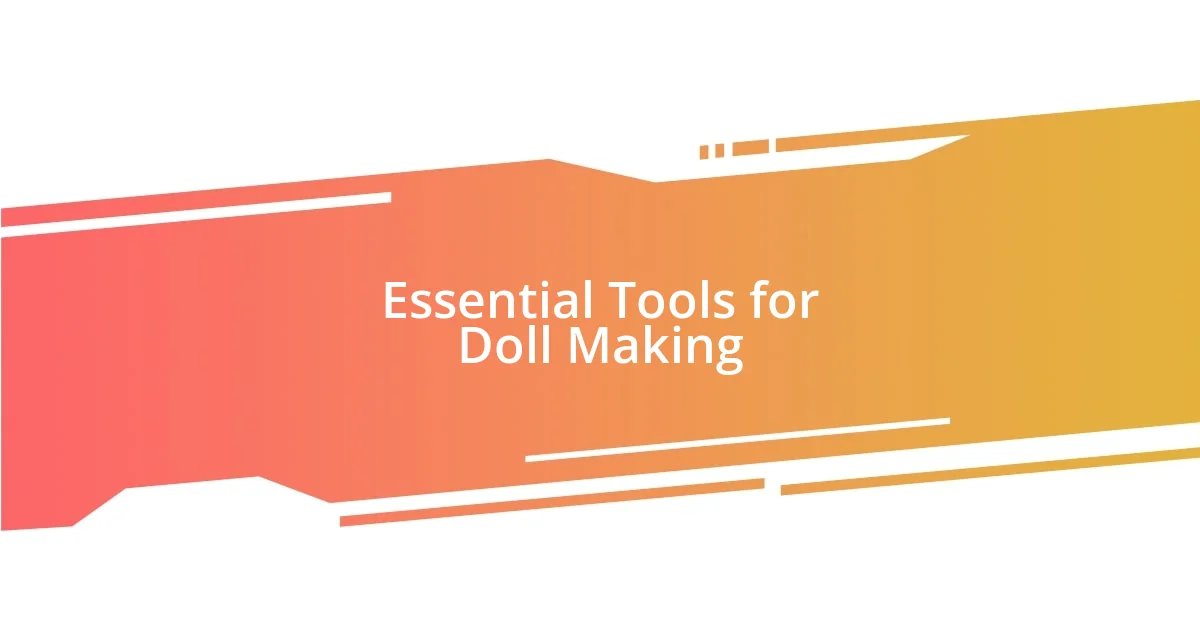
Essential Tools for Doll Making
When it comes to the essential tools for doll making, having the right equipment is a game changer. I can still recall the moment I discovered my trusty pair of fabric scissors; they transformed my cutting experience from a tedious task to a joy. It’s amazing how a good tool can make the process smoother and more enjoyable. Each item you choose for your toolkit adds to your crafting journey and helps you achieve your design goals.
Here are some indispensable tools you might consider for your doll-making arsenal:
- Fabric scissors: Sharp and precise for clean cuts.
- Needles: Various sizes for hand-sewing different materials.
- Straight pins: To hold your fabric pieces in place securely.
- Measuring tape: Essential for getting proportions just right.
- Sewing machine: A time-saver for larger projects, if you’re comfortable using one.
- Fabric glue: Handy for quick attachments or delicate embellishments.
- Stuffing tools: A pokey tool or chopstick can help push stuffing into small openings.
By keeping this list handy, I’ve streamlined my projects and avoided the frustration that comes from scrambling for the right tool mid-creation. Trust me, there’s nothing like knowing that you have everything you need at your fingertips, allowing your creative energy to flow freely. I remember one day, after gathering all my tools in one place, I felt more like an artist than a crafter, just ready to dive into my next doll creation!

Designing Your First Doll
Designing Your First Doll
When I designed my first doll, I was bursting with excitement. I sketched out a character that resonated with me, each detail ranging from eye color to outfit style reflecting my imagination. I quickly learned that every choice shapes the doll’s personality; even small things, like whether to give her a button nose or an embroidered one, can change the overall vibe. Have you considered what personality traits you’d want your doll to express?
As I dived deeper into the design process, I discovered the importance of proportions. I remember feeling overwhelmed by the myriad styles I could choose from, but focusing on my vision helped. For example, making a doll with exaggerated proportions, like a larger head or oversized hands, can create a whimsical character that children might adore. I often ask myself: what story do I want this doll to tell? Finding the answer guides me through my design decisions.
Finally, adding unique embellishments made my dolls feel even more special. One of my favorite modifications was giving a doll hand-knitted accessories. It took time, but the result was worth the effort; it added depth and character that store-bought items just couldn’t match. Have you tried personalizing your designs with something that tells a story? It can truly bring your creation to life and make the process even more rewarding.
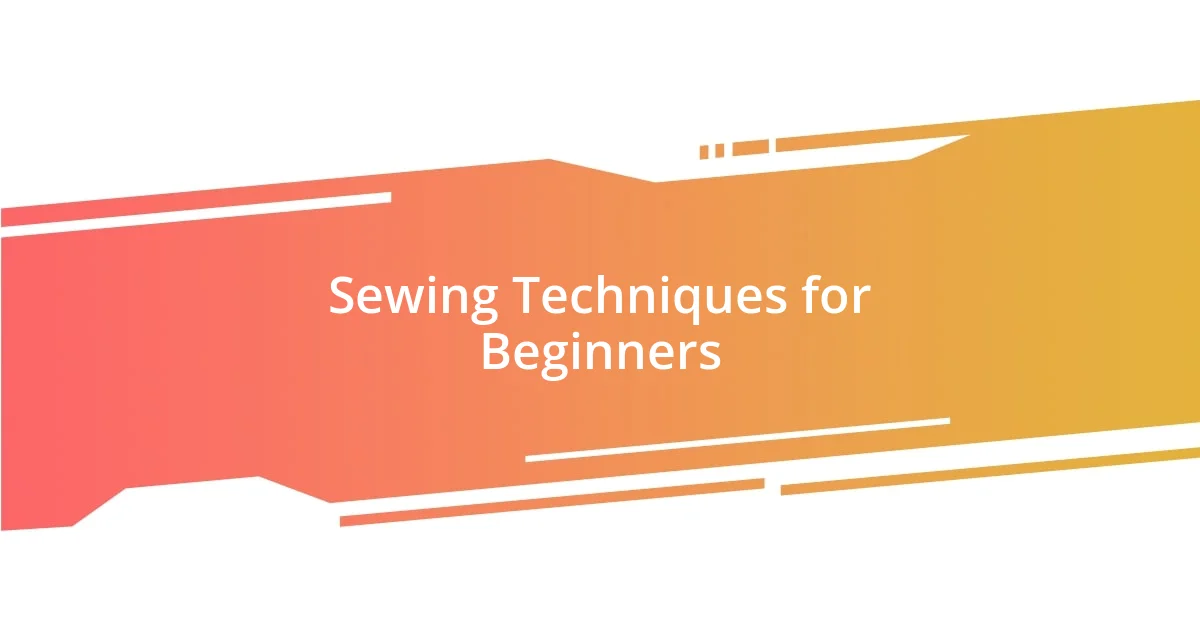
Sewing Techniques for Beginners
As a beginner, mastering a few fundamental sewing techniques can greatly enhance your doll-making experience. I distinctly remember my initial struggles with sewing seams; I often found myself pulling out stitches when they didn’t turn out right. But learning to sew a simple backstitch transformed my approach. It’s such a reliable stitch, perfect for sturdy seams, and offers a satisfying sense of accomplishment as you see your work come together.
Another technique I found invaluable was hand-sewing darts. It may feel a bit tricky at first, but I assure you, once you get the hang of it, the effect is quite rewarding. It’s a technique I still use today; it allows the fabric to shape around the doll’s form beautifully. And let’s be honest, nothing compares to the pride I felt the first time I created those delicate curves, breathing life into my doll.
If you’re planning to incorporate different fabrics, don’t shy away from learning to use bias tape. I didn’t realize how crucial this little strip of fabric could be until I used it for the first time to finish edges on sleeves. It was like opening a new door in my sewing journey! It not only gives a polished look but also adds durability to your project. Have you thought about how your choice of techniques can influence the overall feel of your doll? The options are endless! Don’t be afraid to experiment and find what resonates with you.”

Adding Details and Personal Touches
When it comes to adding details and personal touches, I’ve found that the little things often make the biggest impact. I remember hand-stitching tiny embroidered stars on a doll’s dress, and that act turned an ordinary outfit into something magical. It took time, but seeing those shimmering details come to life made my heart swell—each stitch felt like a whisper of my creativity. Have you thought about how your unique touches could elevate your doll’s character?
One approach that I absolutely cherish is using fabric scraps with sentimental value. For instance, I once crafted a doll from an old shirt that belonged to my grandmother. The nostalgia that fabric carried infused the doll with a story of its own. Every time I glanced at her, I felt a comforting connection to my past. Have you considered what materials hold meaning for you? They can be the perfect way to channel personal memories into your creations.
Lastly, I can’t understate the power of accessories. I often make tiny crocheted hats or scarves that give each doll her own personality. The first time I fashioned a cozy beanie, it transformed a plain doll into a stylish friend. Seeing the doll displayed with her little accessories sparked so much joy in me. What kind of accessories do you envision that could express your doll’s character? Those finishing touches can turn your creation into a cherished treasure.

Common Mistakes to Avoid
When diving into doll-making, one common mistake I see new crafters make is not prewashing their fabrics. I remember the first time I skipped this step—my beautifully sewn dress shrink after the first wash, and it broke my heart. Prewashing isn’t just a precaution; it ensures your materials behave as expected and helps avoid surprising mishaps later on. Have you ever experienced that gut-wrenching moment of seeing your hard work unravel due to unforeseen fabric behavior?
Another pitfall is underestimating the importance of proper tools. I once tried to work with dull scissors and a bent needle, thinking I could make do. Let me tell you, it was a frustrating experience! The right tools make a huge difference in both comfort and precision, allowing you to focus on your creativity rather than battling with equipment. What’s your take on investing in good tools? Often, it can be the difference between a daunting experience and one that’s simply delightful.
Finally, I see many beginners rush through the assembly without taking time to plan their designs. I vividly recall my first doll—I sketched out ideas but got too eager to start sewing. The result? A mismatched doll that left me a bit unsatisfied. Taking a moment to visualize your creation can prevent costly revisions and lead to a doll that beautifully reflects your vision. Have you mapped out your design before jumping in? Trust me, it’s worth the extra effort!










